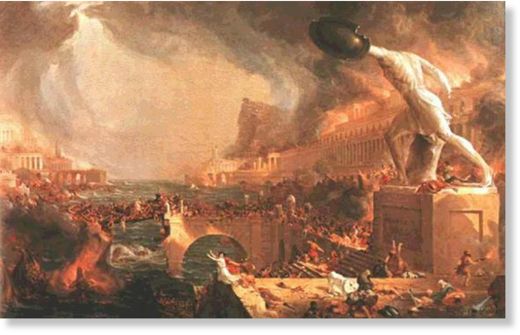
© Unknown
A close shave with a comet nearly 1,500 years ago caused a catastrophic change in the global climate, leading to famine, plague, the end of the Roman Empire, the birth of the Dark Ages and even the legend of King Arthur, a leading British scientist said at the British Association meeting in London yesterday.
Debris from the near miss bombarded the Earth with meteors, which threw enough dust and water vapour into the atmosphere to cut out sunlight and cool the planet to cause crop failure across the northern hemisphere. The cataclysmic famines weakened people's resistance to disease and led to the great plague of the emperor Justinian. It could also be responsible for the Arthurian stories about gods appearing in the sky followed by a fertile kingdom becoming a wasteland.
Mike Baillie, professor of palaeoecology at Queen's University in Belfast, said the central piece of evidence for a sudden global climate change about AD540 comes from the study of tree rings, which highlight the years when plant growth was poor or non-existent. "Oaks live for a long period and in order for a lot of them to show narrow rings at the same time it must have been a profoundly unpleasant event as far as the tree is concerned," Professor Baillie said.
"The event of AD540 is in or at the start of the Dark Ages and in my view probably caused the Dark Ages. It was a catastrophic environmental downturn which shows up in trees from Siberia, Scandinavia, northern Europe, north America and South America," he said. "The idea is that the Earth was hit by a 'cosmic swarm', a whole stack of cometary debris in a short period of time and that loaded the atmosphere with dust and debris and caused some sort of environmental downturn," Professor Baillie explained.Tree rings round the world clearly indicate a major climate change unprecedented in the past two millenniums. This could have cooled the Earth by a few degrees, enough to cause crops to fail for several years in succession.
"It only requires a few degrees cooler conditions across the year for a few years, wiping out several consecutive harvests, and you've got a serious problem for any agricultural society," Professor Baillie said.
"If you weaken a population through starvation and lack of sunlight, they are going to be susceptible to disease. It's a very unpleasant package of an environmental event, famines and plague all happening inside less than a decade. It's nearly impossible to get historians to take this seriously. When confronted with this event, which is clear in the tree records, their immediate reaction is that if something like this had happened, it would be written down. Hence they don't go and look in any real detail to see what is there," he said.
"I am calling for a debate by scientists and historians on how to approach the evidence for catastrophic events of this kind which were previously not known to have taken place. Hints of it appear in mythology, a subject normally taboo for scientists and historians."
Historians believe that King Arthur was a reference to the Irish sky god, Cuchulain. Professor Baillie told the BA meeting: "Clearly, there is some association between the death of Arthur, just around AD540, and a bright Celtic sky god who is described in terms reminiscent of a comet."
He said some authors suggested the AD540 event might be the eruption of a supervolcano. "I don't subscribe to that. I think if there had been one in the 6th century we'd know about it geologically," he said. "In my view we had some sort of interaction with a comet, a cometary bombardment, not a full-blown comet because we wouldn't be here if we'd had that."
Professor John Lowe, a climate scientist at Royal Holloway College, London, said: "It's entirely plausible. In the older geological records we have evidence of such tremendous climatic variability over short timescales and not all of it can be explained by the sort of cyclical phenomena that we know about."
is by far the most absurd post I have ever read in my life by people who haven't got a clue about history. The Roman Empire was VAST. It started to disintegrate from the inside out like the human body , like every empire and what followed is written on a hundred different history books. Jesus people , that comet-danger thing is reaching the boundaries of paranoia.